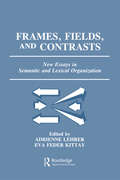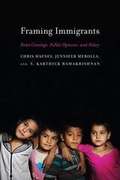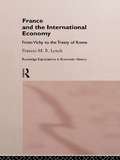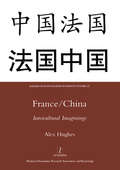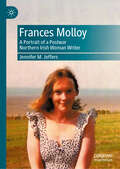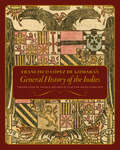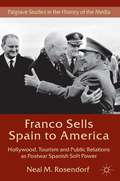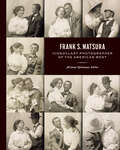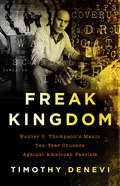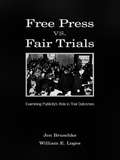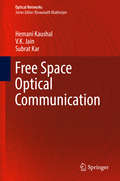- Table View
- List View
Fractal Dimensions of Networks (Springerbriefs In Computer Science Ser.)
by Eric RosenbergCurrent interest in fractal dimensions of networks is the result of more than a century of previous research on dimensions. Fractal Dimensions of Networks ties the theory and methods for computing fractal dimensions of networks to the “classic” theory of dimensions of geometric objects.The goal of the book is to provide a unified treatment of fractal dimensions of sets and networks. Since almost all of the major concepts in fractal dimensions originated in the study of sets, the book achieves this goal by first clearly presenting, with an abundance of examples and illustrations, the theory and algorithms for sets, and then showing how the theory and algorithms have been applied to networks. Thus, the book presents the classical theory and algorithms for the box counting dimension for sets, and then presents the box counting dimension for networks. All the major fractal dimensions are studied, e.g., the correlation dimension, the information dimension, the Hausdorff dimension, the multifractal spectrum, as well as many lesser known dimensions. Algorithm descriptions are accompanied by worked examples, many applications of the methods are presented, and many exercises, ranging in difficulty from easy to research level, are included.
Frames and Framing in Documentary Comics (Palgrave Studies in Comics and Graphic Novels)
by Johannes C.P. SchmidFrames and Framing in Documentary Comics explores how graphic narratives reframe global crises while also interrogating practices of fact-finding. An analog print phenomenon in an era shaped by digitalization, documentary comics formulates a distinct counterapproach to conventional journalism. In what ways are ‘facts’ being presented and framed? What is documentary honesty in a world of fake news and post-truth politics? How can the stories of marginalized peoples and neglected crises be told? The author investigates documentary comics in its unique relationship to framing: graphic narratives are essentially shaped by a reciprocal relationship between the manifest frames on the page and the attention to the cognitive frames that they generate. To account for both the textuality of comics and its strategic use as rhetoric, the author combines theories of framing analysis and cognitive narratology with comics studies and its attention toward the medium’s visual frames.
Frames, Fields, and Contrasts: New Essays in Semantic and Lexical Organization
by Adrienne Lehrer Eva Feder KuttayRecently, there has been a surge of interest in the lexicon. The demand for a fuller and more adequate understanding of lexical meaning required by developments in computational linguistics, artificial intelligence, and cognitive science has stimulated a refocused interest in linguistics, psychology, and philosophy. Different disciplines have studied lexical structure from their own vantage points, and because scholars have only intermittently communicated across disciplines, there has been little recognition that there is a common subject matter. The conference on which this volume is based brought together interested thinkers across the disciplines of linguistics, philosophy, psychology, and computer science to exchange ideas, discuss a range of questions and approaches to the topic, consider alternative research strategies and methodologies, and formulate interdisciplinary hypotheses concerning lexical organization. The essay subjects discussed include: * alternative and complementary conceptions of the structure of the lexicon, * the nature of semantic relations and of polysemy, * the relation between meanings, concepts, and lexical organization, * critiques of truth-semantics and referential theories of meaning, * computational accounts of lexical information and structure, and * the advantages of thinking of the lexicon as ordered.
Frameworks: An Introduction to Film Studies
by Thomas E. Valasek F. Brent Johnson Christopher H. CreekFrameworks sets out to teach both the concepts and the skills beginning students need to become more literate film viewers. Lessons are designed to answer four essential questions: How do films tell a story? How do films reveal characters? How do films depict physical reality? How do films inform, persuade, and indoctrinate? Each of these questions offers a different "framework" for film study, a different way to look at and analyze film.
Framing Devices and Global Legal Traditions: From the Ancient World to the Modern Nation State (Routledge Studies in Comparative Legal History)
by Laura Culbertson Susan Longfield KarrThis collection explores prefaces, prologues, paratexts, and other types of framing devices. Across world history, these devices have introduced the law, articulated its context and audience, identified the basis of legal and moral authority, critiqued existing conditions, or even tried to "restore" something that never was. Scribes, lawmakers, and legal theorists also used frames to position the law in time and space, purporting to define populations and their identities. Despite the ubiquity and complexity of these phenomena, few studies have drawn out methods for studying their role in constructing, fortifying, or reimagining legal frameworks within legal cultures or traditions. This volume offers new ways to consider the significance of framing apparatuses regarding how and why they are created, remembered, forgotten, utilized, and recovered within legal traditions. The studies range from the ancient world to the modern nation-state system, aiming to explore the intersections and collisions between juridical and political interpretation practices.The book will be of interest to academics and researchers in the areas of legal history, comparative law, legal cultures and traditions, legal theory, jurisprudence, constitutional law and legislative drafting.
Framing Immigrants: News Coverage, Public Opinion, and Policy
by S. Karthick Ramakrishnan Chris Haynes Jennifer MerollaWhile undocumented immigration is controversial, the general public is largely unfamiliar with the particulars of immigration policy. Given that public opinion on the topic is malleable, to what extent do mass media shape the public debate on immigration? In Framing Immigrants, political scientists Chris Haynes, Jennifer Merolla, and Karthick Ramakrishnan explore how conservative, liberal, and mainstream news outlets frame and discuss undocumented immigrants. Drawing from original voter surveys, they show that how the media frames immigration has significant consequences for public opinion and has implications for the passage of new immigration policies. The authors analyze media coverage of several key immigration policy issues—including mass deportations, comprehensive immigration reform, and measures focused on immigrant children, such as the DREAM Act—to chart how news sources across the ideological spectrum produce specific “frames” for the immigration debate. In the past few years, liberal and mainstream outlets have tended to frame immigrants lacking legal status as “undocumented” (rather than “illegal”) and to approach the topic of legalization through human-interest stories, often mentioning children. Conservative outlets, on the other hand, tend to discuss legalization using impersonal statistics and invoking the rule of law. Yet, regardless of the media’s ideological positions, the authors’ surveys show that “negative” frames more strongly influence public support for different immigration policies than do positive frames. For instance, survey participants who were exposed to language portraying immigrants as law-breakers seeking “amnesty” tended to oppose legalization measures. At the same time, support for legalization was higher when participants were exposed to language referring to immigrants living in the United States for a decade or more. Framing Immigrants shows that despite heated debates on immigration across the political aisle, the general public has yet to form a consistent position on undocumented immigrants. By analyzing how the media influences public opinion, this book provides a valuable resource for immigration advocates, policymakers, and researchers.
Framing Power in Visigothic Society: Discourses, Devices, and Artifacts (Late Antique and Early Medieval Iberia)
by Céline Martin Eleonora Dell’ ElicineThis volume examines how power was framed in Visigothic society and how a diverse population with a complex and often conflicting cultural inheritance was thereby held together as a single kingdom. Indeed, through this dynamic process a new, early medieval society emerged. Understanding this transformation is no simple matter, as it involved the deployment of an array of political and cultural resources: the production of knowledge, the appropriation of Patristic literature, controlling and administering rural populations, reconceptualizing the sacred, capital punishment and exile, controlling the manufacture of currency, and defining Visigothic society in relation to other polities such as the neighbouring Byzantine state. In order to achieve an analysis of these different phenomena, this volume brings together researchers from a variety of disciplines. This interdisciplinary approach therefore expands the available sources and reformulates topics of traditional scholarship in order to engage with a renewal of Visigothic Studies and reformulate the paradigm of study itself. As a result, this volume rethinks frameworks of power in the Peninsula along not only historical and archaeological but also anthropological terms, presenting the reader with a new understanding of Iberian society as a whole.
Framing Public Life: Perspectives on Media and Our Understanding of the Social World (Routledge Communication Series)
by Jr. August E. Grant Stephen D. Reese Oscar H. GandyThis distinctive volume offers a thorough examination of the ways in which meaning comes to be shaped. Editors Stephen Reese, Oscar Gandy, and August Grant employ an interdisciplinary approach to the study of conceptualizing and examining media. They illustrate how texts and those who provide them powerfully shape, or "frame," our social worlds and thus affect our public life. Embracing qualitative and quantitative, visual and verbal, and psychological and sociological perspectives, this book helps media consumers develop a multi-faceted understanding of media power, especially in the realm of news and public affairs.
Framing Sustainability in Language and Communication (Routledge Research in Language and Communication)
by Maida Kosatica Sean P. SmithThis collection brings together established and emerging scholars for a critical framing of sustainability through the lens of language and communication, social semiotics, and media studies. The volume underscores the importance of re-envisioning sustainability around not only climate change and biodiversity loss but in broader systems of ecological, social, and economic imbalances on a global scale.The book begins with a visual essay which provides a semiotic foundation for understandings of sustainability across disciplinary approaches in the chapters that follow. Subsequent chapters are organized around four thematic parts: reframing sustainability in a colonial world; the semiotics of sustainability; communicating sustainability in everyday life; and sustainability communication in the arts. A closing commentary by Crispin Thurlow offers critical reflections on sustainability within language and communication research and beyond.This book will be of interest to scholars addressing sustainability across diverse disciplines, including language and communication, social semiotics, linguistic anthropology, environmental communication, media studies, and development studies.
Framing the Rhetoric of a Leader: An Analysis of Obama’s Election Campaign Speeches
by M. DeganiBased on a selection of 30 election campaign speeches during Obama's first run for the American presidency in 2008, this book investigates the Democratic presidential candidate's much celebrated rhetoric from a cognitive semantics point of view.
France and the International Economy: From Vichy to the Treaty of Rome (Routledge Explorations in Economic History)
by Frances LynchThis is a comprehensive history of a critically formative period in French economic history. Frances Lynch covers topics such as the post-war negotiations for American aid, the reconstruction of a capital market, the modernization of French agriculture, the liberalization of trade in the 1950s and subsequent economic growth.
France/China: Intercultural Imaginings
by Alex HughesChina has long been an object of fascination for the French, who celebrated theirannee de la Chine in 2004. Symptomatic of that fascination are the movements into China made by groups as diverse as the Jesuits, who arrived inL'Empire du Milieu in the late seventeenth century, and theTel Quel intellectuals, whose will to political pilgrimage took th
Frances Burney’s “Evelina”: The Book, its History, and its Paratext (New Directions in Book History)
by Svetlana KochkinaEvelina, the first novel by Frances Burney, published in 1778, enjoys lasting popularity among the reading public. Tracing its publication history through 174 editions, adaptations, and reprints, many of them newly discovered and identified, this book demonstrates how the novel’s material embodiment in the form of the printed book has been reshaped by its publishers, recasting its content for new generations of readers. Four main chapters vividly describe how during 240 years, Evelina, a popular novel of manners, metamorphosed without any significant alterations to its text into a Regency “rambling” text, a romantic novel for “lecteurs délicats,” a cheap imprint for circulating libraries, a yellow-back, a book with a certain aesthetic cachet, a Christmas gift-book, finally becoming an integral part of the established literary canon in annotated scholarly editions. This book also focuses on the remodelling and transformation of the paratext in this novel, written by a woman author, by the heavily male-dominated publishing industry. Shorter Entr’acte sections discuss and describe alterations in the forms of Burney’s name and the title of her work, the omission and renaming of her authorial prefaces, and the redeployment of the publisher’s prefatorial apparatus to support particular editions throughout almost two-and-a-half centuries of the novel’s existence. Illustrated with reproductions of covers, frontispieces, and title pages, the book also provides an illuminating insight into the role of Evelina’s visual representation in its history as a marketable commodity, highlighting the existence of editions targeting various segments of the book market: from the upper-middle-class to mass-readership. The first comprehensive and fully updated bibliography of English and translated editions, adaptations, and reprints of Evelina published in 13 languages and scripts appears in an appendix.
Frances Molloy: A Portrait of a Postwar Northern Irish Woman Writer
by Jennifer M. JeffersFrances Molloy: The Portrait of a Postwar Northern Irish Woman Writer is the story of Ann McGill Brady, the woman who wrote herself into the history of the Irish novel as Frances Molloy. It is also the story of a poor, uneducated, Catholic female in Northern Ireland in the 1960s; she had few choices and they were the traditional ones: marriage or work a dead-end job. For young Molloy, marriage was out the question because she did not want to replicate her own mother&’s life. Molloy believed that God did have a higher plan for her life, and she believed that she would better serve the world as a nun than as a seamstress in a pajama factory. Frances Molloy gives a voice to the poverty, prejudice, and violence the Catholic community endured in Northern Ireland under the Stormont Government in the post-World War II era. While identity is always at the forefront of society in Northern Ireland, there is little record of the Catholic female, bound by tradition and poverty, in the North. A group without a history is a group without an identity—no one has yet written a history of the poor Northern Irish Catholic female in the latter half of the twentieth century. Frances Molloy was a Catholic woman in a sectarian state, and her story includes discrimination, segregation, and unjust incarceration in Northern Ireland in the latter half of the twentieth century.
Francisco López de Gómara's General History of the Indies
by Clayton Miles Lehmann Angela HelmerThis work is the first English translation of the entire text of part one of sixteenth-century Spanish historian Francisco López de Gómara’s General History of the Indies. Including substantial critical annotations and providing access to various readings and passages added to or removed from the successive editions of the 1550s, this translation expands the archive of texts available to English speakers reconsidering the various aspects of the European invasion of America. General History of the Indies was the first universal history of the recent discoveries and conquests of the New World made available to the Old World audience. At publication it consisted of two parts: the first a general history of the European discovery, conquest, and settlement of the Americas, and the second a detailed description of Cortés’s conquest of Mexico. Part one—in the multiple Spanish editions and translations into Italian and French published at the time—was the most comprehensive, popular, and accessible account of the natural history and geography of the Americas, the ethnology of the peoples of the New World, and the history of the Spanish conquest, including the most recent developments in Peru. Despite its original and continued importance, however, it had never been translated into English. Gómara’s history communicates Europeans’ general understanding of the New World throughout the middle and later sixteenth century. A lively, comparatively brief description of Europe’s expansion into the Americas with significant importance to today’s understanding of the early modern worldview, Francisco López de Gómara’s General History of the Indies will be of great interest to students of and specialists in Latin American history, Latin American literature, anthropology, and cultural studies, as well as specialists in Spanish American intellectual history and colonial Latin America.
Franco Sells Spain to America
by Neal M. RosendorfA groundbreaking study of the Franco regime's utilization of Hollywood film production in Spain, American tourism, and sophisticated public relations programs - including the most popular national pavilion at the 1964-65 New York World's Fair - in a determined effort to remake the Spanish dictatorship's post-World War II reputation in the US.
Frank Chance's Diamond: The Baseball Journalism of Ring Lardner
by Ron Rapoport&“This is a comprehensive volume capturing the Lardner style and offering a considerable insight into America&’s favorite sportswriter… Ron Rapoport has done a superb job in his selection&“—The New York Journal of Books &“Frank Chance's Diamond is a time machine. . .Lardner's writing reveals its exuberance and innocence, and exposes its prejudices, all while highlighting the joys of the era's baseball.&”— Epoch TimesAt one time Ring Lardner&’s baseball articles reached millions of readers through more than one hundred newspapers throughout America. Admirers of his writing included F. Scott Fitzgerald, H.L. Mencken, Edmund Wilson, and Virginia Woolf. He was as familiar to Americans in the 1920s as Charles Lindbergh, Calvin Coolidge, Henry Ford, and Babe Ruth. His articles about the players he knew, his World Series coverage, his poems, parodies, and jokes were unlike any other baseball reporting ever written, both in his time and since.Even a hundred years later, Lardner&’s baseball journalism makes for delightful, often wildly funny, reading and offers a glimpse of where his ground-breaking baseball fiction came from. This book contains Lardner&’s columns about Christy Mathewson, Ty Cobb, Babe Ruth, Casey Stengel, and Three-Finger Mordecai Brown and some fabulous lesser-known characters like Frank Schulte, Heine Zimmerman, Jim Schekard, Johnny Kling, Rollie Zeider, and Peaches Graham, as well as examples of Lardner&’s coverage of the World Series—including the notorious 1919 Black Sox Series. Ron Rapoport&’s introduction puts Lardner in his time and place and explains how his writing about baseball developed over the years.
Frank S. Matsura: Iconoclast Photographer of the American West
by Michael HollomanA captivating collection of Native American portraiture by early 20th-century Japanese photographer Frank S. Matsura frames the rarely told story of his work and unique personal life.Frank S. Matsura (1873-1913) was an immigrant photographer, a local hero, a charismatic original, an enigma, and a man of the community whose legacy has grown over time. Today, historians are still compiling the details of Frank’s unconventional life, and his identity and images are enjoying a revival. An expansion of academic scholarship, documentaries, exhibitions, and regional historical interests, particularly regarding his Native American portraiture, has resulted in a more vivid understanding of the man and his work: Matsura’s photographs of local tribal members reveal an honesty and empathy, a counterpoint to the contrived or nostalgic seen in his contemporaries’ images from the same period. His oeuvre of just ten years (due to his unexpected passing from tuberculosis) documents everyday local events and the cacophony of characters who visited his studio for dime portraits. There are parallels to be found between Matsura’s work and today’s society in attempts to rise above anti-Asian bias, the continued pursuit of cultural agency, and a desire to individually define what America can and should be. Along with beautifully reproduced black-and-white photographs, the book features narratives from five scholars who give life and context to Matsura’s work, celebrating his captivating photography as a look into immigrant artists, American identity, and the history of a fluid and multicultured exceptionalism.THE FIRST COMPREHENSIVE BOOK OF ITS KIND: Frank Matsura was a Japanese-born photographer who lived in northern Washington State in the early 20th century. This is a rare and comprehensive exploration of his life, including the juxtaposition of his work against the images of Native American people by American photographer Edward S. Curtis. MATSURA'S SINGULAR WORK AND STYLE: Matsura’s work broke many cultural and photographic taboos of the time. He took candid and relaxed photos of his subjects, including local Native American tribes. Many of his images were spontaneous group photos of locals in character and costume. He included himself in many of his photos, and he included interracial couples in his images as well. A HIDDEN FIGURE WHOSE TIME HAS COME: This collection was based on a 2023 exhibit at the Northwest Museum of Arts and Culture. Interest in Matsura’s work has gained momentum over the years, and this book coincides with the release of Emmy Award–winning filmmaker Beth Harrington’s documentary Our Mr. Matsura on his work and legacy.Perfect for: American and Native American history buffs Photographers and artists Fans of Frank Matsura's unconventional story and work Lovers of vintage, historical, and portrait photography
Frankness, Greek Culture, and the Roman Empire (Routledge Monographs in Classical Studies)
by Dana FieldsFrankness, Greek Culture, and the Roman Empire discusses the significance of parrhēsia (free and frank speech) in Greek culture of the Roman empire. The term parrhēsia first emerged in the context of the classical Athenian democracy and was long considered a key democratic and egalitarian value. And yet, references to frank speech pervade the literature of the Roman empire, a time when a single autocrat ruled over most of the known world, Greek cities were governed at the local level by entrenched oligarchies, and social hierarchy was becoming increasingly stratified. This volume challenges the traditional view that the meaning of the term changed radically after Alexander the Great, and shows rather that parrhēsia retained both political and ethical significance well into the Roman empire. By examining references to frankness in political writings, rhetoric, philosophy, historiography, biographical literature, and finally satire, the volume also explores the dynamics of political power in the Roman empire, where politics was located in interpersonal relationships as much as, if not more than, in institutions. The contested nature of the power relations in such interactions - between emperors and their advisors, between orators and the cities they counseled, and among fellow members of the oligarchic elite in provincial cities - reveals the political implications of a prominent post-classical intellectual development that reconceptualizes true freedom as belonging to the man who behaves - and speaks - freely. At the same time, because the role of frank speaker is valorized, those who claim it also lay themselves open to suspicions of self-promotion and hypocrisy. This volume will be of interest to students and scholars of rhetoric and political thought in the ancient world, and to anyone interested in ongoing debates about intellectual freedom, limits on speech, and the advantages of presenting oneself as a truth-teller.
Freak Kingdom: Hunter S. Thompson's Manic Ten-Year Crusade Against American Fascism
by Timothy DeneviThe story of Hunter S. Thompson's crusade against Richard Nixon and the threat of fascism in America--and the devastating price he paid for it <P><P>Hunter S. Thompson is often misremembered as a wise-cracking, drug-addled cartoon character. <p><p>This book reclaims him for what he truly was: a fearless opponent of corruption and fascism, one who sacrificed his future well-being to fight against it, rewriting the rules of journalism and political satire in the process. This skillfully told and dramatic story shows how Thompson saw through Richard Nixon's treacherous populism and embarked on a life-defining campaign to stop it. <p><p>In his fevered effort to expose institutional injustice, Thompson pushed himself far beyond his natural limits, sustained by drugs, mania, and little else. For ten years, he cast aside his old ambitions, troubled his family, and likely hastened his own decline, along the way producing some of the best political writing in our history. <p><p>This timely biography recalls a period of anger and derangement in American politics, and one writer with the guts to tell the truth.
Frederick Douglass: Frederick Douglass And Transatlantic Reform (Norton Critical Editions Ser. #0)
by William S. McFeely“A detailed, finely written portrait of the imposing 19th-century leader.” —David Levering Lewis, New York Times Book Review Born into but escaped from slavery, Frederick Douglass—orator, journalist, autobiographer; revolutionary on behalf of a just America—was a towering figure, at once consummately charismatic and flawed. His Narrative of the Life of Frederick Douglass (1845) galvanized the antislavery movement and is one of the truly seminal works of African-American literature. In this Lincoln Prize– winning biography, William S. McFeely captures the many sides of Douglass— his boyhood on the Chesapeake; his self-education; his rebellion and rising expectations; his marriage, affairs, and intense friendships; his bitter defeat and transcendent courage—and re-creates the high drama of a turbulent era.
Free Days With George
by Colin CampbellA heartwarming, true story about George, a rescue dog who helps his owner rediscover love and happiness. Marley & Me meets Tuesdays with Morrie and The Art of Racing in the Rain--get your tissues ready, animal lovers! After Colin Campbell went on a short business trip abroad, he returned home to discover his wife of many years had moved out. No explanations. No second chances. She was gone and wasn't coming back. Shocked and heartbroken, Colin fell into a spiral of depression and loneliness. Soon after, a friend told Colin about a dog in need of rescue--a neglected 140-pound Newfoundland Landseer, a breed renowned for its friendly nature and remarkable swimming abilities. Colin adopted the traumatized dog, brought him home and named him George. Both man and dog were heartbroken and lacking trust, but together, they learned how to share a space, how to socialize, and most of all, how to overcome their bad experiences. At the same time, Colin relived childhood memories of his beloved grandfather, a decorated war hero and a man who gave him hope when he needed it most.Then everything changed. Colin was offered a great new job in Los Angeles, California. He took George with him and the pair began a new life together on the sunny beaches around L.A. George became a fixture in his Hermosa Beach neighborhood, attracting attention and giving affection to everyone he met, warming hearts both young and old. Meanwhile, Colin headed to the beach to rekindle his love for surfing, but when George encountered the ocean and a surfboard for the first time, he did a surprising thing--he jumped right on the board. Through surfing, George and Colin began a life-altering adventure and a deep healing process that brought them back to life. As their story took them to exciting new heights, Colin learned how to follow George's lead, discovering that he may have rescued George but that in the end, it was George who rescued him. Free Days with George is an uplifting, inspirational story about the healing power of animals, and about leaving the past behind to embrace love, hope and happiness.From the Hardcover edition.
Free Expression, Globalism and the New Strategic Communication
by Monroe E. PriceVast changes in technologies and geopolitics have produced a wholesale shift in the way states and other powerful entities think about the production and retention of popular loyalties. Strategic communication has embraced these changes as stakes increase and the techniques of information management become more pervasive. These shifts in strategic communications impact free speech as major players, in a global context, rhetorically embrace a world of transparency, all the while increasing surveillance and modes of control, turning altered media technologies and traditional media doctrines to their advantage. Building on examples drawn from the Arab Spring, the shaping of the Internet in China, Iran's perception of foreign broadcasting, and Russia's media interventions, this book exposes the anxieties of loss of control, on the one hand, and the missed opportunities for greater freedom, on the other. "New" strategic communication arises from the vast torrents of information that cross borders and uproot old forms of regulation. Not only states but also corporations, nongovernmental organizations, religious institutions, and others have become part of this new constellation of speakers and audiences.
Free Press Vs. Fair Trials: Examining Publicity's Role in Trial Outcomes (Routledge Communication Series)
by Jon Bruschke William Earl LogesCurrent research on media and the law has generally been atheoretical and contradictory. This volume explains why pretrial publicity is unlikely to affect the outcome of most jury trials, despite many experimental studies claiming to show the influence of publicity. It reviews existing literature on the topic and includes results from the authors' own research in an effort to answer four questions: *Does pretrial publicity bias the outcome of trials? *If it has an effect, under what conditions does this effect emerge? *What remedies should courts apply in situations where pretrial publicity may have an effect? *How does pretrial publicity relate to broader questions of justice? Reporting research based on actual trial outcomes rather than on artificial laboratory studies, Free Press vs. Fair Trials examines publicity in the context of the whole judicial system and media system. After a thorough review of research into pretrial publicity, the authors argue that the criminal justice system's remedies are likely to be effective in most cases and that there are much larger obstacles confronting defendants than publicity. This book presents the first extensive study of the influence of pretrial publicity on actual criminal trials, with results that challenge years of experimental research and call for more sophisticated study of the intersection of media and criminal justice. It is required reading for scholars in media law, media effects, legal communication, criminal justice, and related areas.
Free Space Optical Communication
by Hemani Kaushal V. K. Jain Subrat KarThis book provides an in-depth understanding of free space optical (FSO) communication with a particular emphasis on optical beam propagation through atmospheric turbulence. The book is structured in such a way that it provides a basic framework for the beginners and also gives a concise description from a designer's perspective. The book provides an exposure to FSO technology, fundamental limitations, design methodologies, system trade-offs, acquisition, tracking and pointing (ATP) techniques and link-feasibility analysis. The contents of this book will be of interest to professionals and researchers alike. The book may also be used as a textbook for engineering coursework and professional training.


